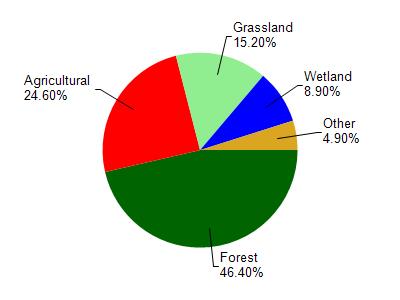Sauk
Yes
Yes
No
Fish and Aquatic Life
Overview
Biser Creek is a tributary to Bear Creek that enters just above Pumpkin Hollow Creek. Biser Creek is considered a Class I fishery and has natural reproduction of both brook and brown trout. The creek is designated an exceptional resource water (ERW). It has been recommended that the creek be upgraded to Class I trout stream status. The creek has been hydrologically modified and has some problems with nonpoint source pollution. The creek would benefit from a nonpoint source pollution reduction project.
From: Ripp, Coreen, Koperski, Cindy and Folstad, Jason. 2002. The State of the Lower Wisconsin River Basin. PUBL WT-559-2002. Wisconsin Department of Natural Resources, Madison, WI
Date 2002
Author Cynthia Koperski
Condition
Wisconsin has over 84,000 miles of streams, 15,000 lakes and milllions of acres of wetlands. Assessing the condition of this vast amount of water is challenging. The state's water monitoring program uses a media-based, cross-program approach to analyze water condition. An updated monitoring strategy (2015-2020) is now available. Compliance with Clean Water Act fishable, swimmable standards are located in the Executive Summary of Water Condition in 2018. See also the 'monitoring and projects' tab.
Reports
Recommendations
Trout Classification Mgmt
Biser Creek should be reclassified from a Class II trout stream to a Class I.
Management Goals
Wisconsin's Water Quality Standards provide qualitative and quantitative goals for waters that are protective of Fishable, Swimmable conditions [Learn more]. Waters that do not meet water quality standards are considered impaired and restoration actions are planned and carried out until the water is once again fishable and swimmable
Management goals can include creation or implementation of a Total Maximum Daily Load analysis, a Nine Key Element Plan, or other restoration work, education and outreach and more. If specific recommendations exist for this water, they will be displayed below online.
Monitoring
Monitoring the condition of a river, stream, or lake includes gathering physical, chemical, biological, and habitat data. Comprehensive studies often gather all these parameters in great detail, while lighter assessment events will involve sampling physical, chemical and biological data such as macroinvertebrates. Aquatic macroinvertebrates and fish communities integrate watershed or catchment condition, providing great insight into overall ecosystem health. Chemical and habitat parameters tell researchers more about human induced problems including contaminated runoff, point source dischargers, or habitat issues that foster or limit the potential of aquatic communities to thrive in a given area. Wisconsin's Water Monitoring Strategy was recenty updated.
Grants and Management Projects
| Project Name (Click for Details) | Year Started |
|---|
|
|
Monitoring Projects
| WBIC | Official Waterbody Name | Station ID | Station Name | Earliest Fieldwork Date | Latest Fieldwork Date | View Station | View Data |
|---|
| 1236000 | Biser Creek | 10030166 | Biser Creek along CTH N T10N R3E St. #19-13c | | | Map | Data |
| 1236000 | Biser Creek | 10041029 | 27 Meters Upstream of Biser Valley Farm Driveway | 1/1/2015 | 1/1/2015 | Map | Data |
| 1236000 | Biser Creek | 10030157 | Biser Creek US of CTH N T10 R3E Str. 20-4 | | | Map | Data |
|

Watershed Characteristics
Biser Creek is located in the Bear Creek watershed which is 136.54 mi². Land use in the watershed is primarily forest (46.40%), agricultural (24.60%) and a mix of grassland (15.20%) and other uses (13.80%). This watershed has 236.07 stream miles, 119.46 lake acres and 6,798.61 wetland acres.
Nonpoint Source Characteristics
This watershed is ranked Medium for runoff impacts on streams, Not Ranked for runoff impacts on lakes and High for runoff impacts on groundwater and therefore has an overall rank of High. This value can be used in ranking the watershed or individual waterbodies for grant funding under state and county programs.This water is ranked High Stream for individual Rivers based on runoff problems and the likelihood of success from project implementation.